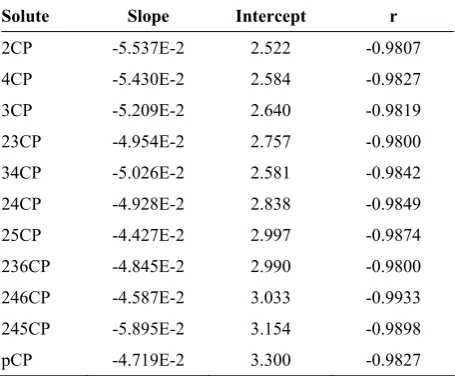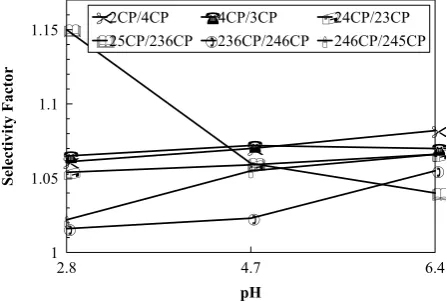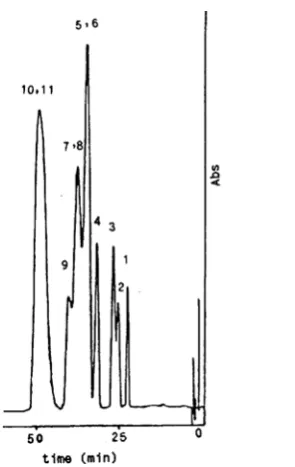EVALUATION OF THE USE OF ANIONIC/ NONIONIC MIXED MICELLES
IN REVERSED PHASE LIQUID CHROMATOGRAPHY
OF CHLOROPHENOLS
M. R. Hadjmohammadi and F. Safa
*Institute of Chemistry, Mazandaran University, P.O. Box 453, Babolsar, Islamic Republic of Iran
Abstract
The use of aqueous mixed micellar system consisting of sodium dodecyl
sulfate (SDS) and polyoxyethylene (23) dodecanol (Brij-35) as the mobile phase
in reversed-phase liquid chromatography was studied. A group of chlorophenols
was used as the test mixture. Adding organic modifier to the system showed that
the use of low concentrations of organic additives improves efficiency in
SDS/Brij-35 mixed micellar mobile phase. The effects of propanol concentration,
total surfactant concentration and pH upon retention and selectivity were also
assessed. It was shown that a linear correlation exists between LnK
′
and volume
fraction of propanol over a range of 0-10%. Also, a regular decrease in solutes
retention was observed as a function of surfactant concentration. The results
showed that the elution strength increases as the mobile phase pH decreases. It
was also revealed that the chromatographic selectivity changes with an increase in
elution strength.
* E-mail: safa_f@yahoo.com
Introduction
In the last two decades, the popularity of micellar liquid chromatography (MLC) as an alternative to reversed-phase liquid chromatography (RPLC) has increased. Micellar liquid chromatography has extended the capability of RPLC by allowing rapid gradient elution, detection sensitivity enhancement, unique separation selectivity, etc. [1-6]. The existence of solute-micelle interactions is a noticeable characteristic of micellar liquid chromatographic separations. In
Keywords: Micellar liquid chromatography; Mixed micelle; Chlorophenols
MLC, a solute can associate with the micellar pseudo
phase through a combination of electrostatic, hydrop-hobic and steric interactions [7]. The type of interaction depends upon the solute and micelle properties. Thus, retention and selectivity can be more easily controlled by variation in type and concentration of surfactants.
mixed micelles shows negative deviation from ideality such that the critical micelle concentration of the mixture of surfactants is lower than what is predicted based on the ideal solution theory [11].
In this paper, the results of a study on the effect of adding organic modifiers to the system on chromatogra-phic efficiency are reported. The influence of organic modifier, micelle concentration and pH on elution stren-gth and selectivity in mixed micellar liquid chromato-graphy of chlorophenols is also described.
Experimental Section
Apparatus
The HPLC system consisted of a 6000A pump, M600 solvent programmer, and UK injector, all from Waters (Waters. Assoc. Milford, MA, USA) and a Perkin-Elmer (Norwalk, CT, USA) LC-95 UV detector set at 254 nm. The columns used were: 5 µ Waters Resolve C18 (150×3.9 mm I.D) and 10 µ Waters Bonda Pak C18 (300×3.9 mm I.D). Columns were thermostated at 40°C by a water circulator bath. The pH of mobile phase was measured with Ciba-Corning Model 250 pH meter.
Materials
The surfactants, SDS and Brij-35, and test solutes were used as received from Fluka. HPLC grade methanol (MeOH), ethanol (EtOH), propanol (PrOH), isopropanol (iso-PrOH) and butanol (BuOH) were also obtained from Fluka. The test solutes were 2-(2CP), 3-(3CP) and 4-chlorophenol (4CP), 2,3-(23CP), 2,4-(24CP), 2,5-(25CP) and 3,4-dichlorophenol (34CP), 2,4,5-(245CP), 2,4,6-(246CP) 2,3,6-trichlorophenol (236CP) and pentachlorophenol (pCP). The micellar solutions were prepared in double distilled, deionized water and were filtered through a 0.45 μm Millipore solvent filter. The stock solutions of chlorophenols (0.5-1 mg/ml) were prepared in methanol. The mobile phase pH was adjusted by adding phosphate buffer.
Methods
The chromatographic efficiency was calculated using the manual procedure of Foley and Dorsey [12], as Equation 1:
1.25 (B/A)
) /W 41.7(t
N r 0.1 2
+
= (1)
where tr is the solute retention time, W0.1 is the peak
width measured at 10% peak height, and B/A is the peak asymmetry factor. The capacity factor, K′, was calculated in the usual manner using methanol as void marker.
Results and Discussion
Organic Modifier Effects on Chromatographic
Efficiency
A major disadvantage of MLC is lower efficiency when compared to conventional reversed-phase liquid chromatography [7]. This low efficiency is caused by slow mass transfer due to poor wetting of the stationary phase. It has been shown that the efficiency can be improved by adding small quality of an organic modifier to the mobile phases containing simple micelles [8].
The effects of various alcohol additives on chromatographic efficiency using a SDS/Brij-35 mixed micellar eluent are presented in Table 1. Like other micellar mobile phases, an improvement is seen in both peak symmetry and plate count as the polarity of the organic modifier is decreased and wetting of the stationary phase is enhanced. Adding of low concentrations of organic modifiers also increases the elution strength and decreases the test solute retention. The results show that capacity factor decreases as the hydrophobicity of the organic co-solvent is increased.
The effect of the propanol concentration on chromatographic efficiency in a SDS/Brij-35 micellar mobile phase was also determined. As shown in Table 2, efficiency improves as a function of propanol concentration over a range of 0-5%. Little improvement is seen when concentration of propanol exceeds 5%.
Effect of Propanol Concentration on Retention In hybrid systems (simple micelles in hydro-organic mobile phases), an increase in organic solvent concentration, causes an increase in the elution strength and decrease in the solutes retentions. The correlation between capacity factor and volume fraction of organic modifier (φ) can be written as Equation 2 [13]:
o
hyb LnK
S K
Ln ′=− ϕ+ ′ (2)
where Shyb is solvent strength parameter in hybrid
system and K′o is the capacity factor in purely aqueous
micellar eluent.
Equation 2 adequately describes (r>0.98) the retention behavior of the test mixture of chlorophenols in SDS/Brij-35 mixed micellar LC as a function of volume fraction of propanol over a range of 0-10% (Table 3). The degree of reduction in retention isn’t the same for different solutes and this can lead to changes in selectivity. The correlation between S and LnK′o for
fraction of propanol added to micellar eluents.
Table 1. Effect of organic modifiers on chromatographic efficiency
Organic modifier K′ N B/A
None 12.75 2775 1.40
MeOH 12.06 3212 1.27
EtOH 11.54 3525 1.18
i-PrOH 11.00 3729 1.05
PrOH 10.00 3861 1.05
BuOH 6.75 4206 1.05
Conditions: 150 mm 5 µ C18 column, flow rate 0.9 ml/min, mobile phase 25 mM SDS+25 mM Brij-35+5%(v/v) organic modifier, 40°C, 2CP test solute.
Table 2. Effect of Propanol concentration on chromatographic efficiency
Propanol (v/v%) 0.0 1.0 3.0 5.0 7.0 10.0 N 2775 3096 3504 3861 3038 2988
B/A 1.40 1.15 1.05 1.05 1.07 1.20
Conditions are as in Table 1.
Table 3. Results of regression analysis from LnK′ vs volume fraction of Propanol
Solute Slope Intercept r
2CP -5.537E-2 2.522 -0.9807
4CP -5.430E-2 2.584 -0.9827
3CP -5.209E-2 2.640 -0.9819
23CP -4.954E-2 2.757 -0.9800 34CP -5.026E-2 2.581 -0.9842 24CP -4.928E-2 2.838 -0.9849 25CP -4.427E-2 2.997 -0.9874 236CP -4.845E-2 2.990 -0.9800 246CP -4.587E-2 3.033 -0.9933 245CP -5.895E-2 3.154 -0.9898
pCP -4.719E-2 3.300 -0.9827
Conditions: 150 mm 5 µ C18 column, flow rate 0.9 m1/min, mobile phase 25 mM SDS +25 mM Brij-35 and 0-10% propanol, 40°C. 2.522 2.584 2.64 2.757 2.838 2.581 2.997 2.99 3.033 3.154 3.3 lnK' 4.3 4.8 5.3 5.8 S* 10 0 o PCP 2CP 4CP 3CP 23DCP 24DCP 34DCP 25DCP 236TCP 246TCP 245TCP
Figure 1. Relation between Shyb value and retention in SDS/
Brij-35 micellar mobile phase. Conditions are as in Table 3.
0 3 5
% PrOH 0.99 1.04 1.09 1.14 S el ec ti vi ty F ac to r 10 2CP/4CP 4CP/3CP 24CP/23CP 25CP/236CP 236CP/246CP 246CP/245CP
Figure 2. Variation of selectivity with the volume fraction of PrOH in SDS/Brij-35 micellar mobile phase. Conditions are as in Table 2.
20 30 45 55
Total Surfactant Concentration (mM) 0.9 1 1.1 1.2 1.3 1.4 1.5 S el ec ti vi ty F ac to r
2CP/4CP 4CP/3CP 24CP/23CP 25CP/236CP 236CP/246CP 246CP/245CP
Effects of Surfactant Concentration on Retention and Selectivity
The effect of simple micelles on retention in RPLC has been reported by a number of authors [5,14,15]. They showed that an increase in surfactant concent-ration usually leads to a decrease in retention.
In MLC using SDS/Brij-35 mixed micellar eluent, a good correlation (r>0.99) between 1/K′ and total surfactant concentration was observed for all solutes (Table 4). Our results show that the solutes studied in this work are highly bonding solutes with SDS/Brij-35 mixed micellar mobile phase. The degree of decrease in retention for different compounds varies depending on their partition coefficients into mixed micelles and stationary phase. Due to different types of the competing equilibria in MLC, one can expect any form of selectivity behavior as a result of a change in micelle concentration. Figure 3 shows the variation of selectivity with the total surfactant concentration in micellar mobile phase. As shown, convergence, divergence or reversal of the peaks can occur as a result of an increase in total surfactant concentration.
Mobile Phase pH Effects
The pH of the micellar eluent is an important factor for the analysis of ionizable compounds. The influence of the mobile phase pH on the chromatographic behavior of chlorophenol compounds was studied. The results are presented in Table 5. The capacity factor is found to increase as the mobile phase pH is increased. Retention in MLC is inversely related to the solute-micelle binding constant (Km) in following form [12]:
1) [M]
Φ)/(K (P
K′= s m + (3)
where Ps is the partition coefficient of solute between
the mobile and stationary phases, Φ is the phase ratio and [M] is the micelle concentration. Therefore, it is concluded that Km for all solutes decreases with an
increase in the mobile phase pH. This behavior can be attributed to the fact that the activation barriers to sorption/desorption is greater in SDS/Brij-35 systems at higher pH due to greater electrostatic hinderence to mass transfer. The change in the mobile phase pH affects nonionic Brij-35 surfactants because the ether linkage in those polyoxyethylene chains can be protonated at low pH yielding positively charged groups [16]. Based on this assumption, one can be expected that protonated nonionic surfactants reduce the net electrical charge density of anionic surfactants in SDS/Brij-35 mixed micellar systems. Our observation also indicates that a decrease in pH usually leads to a decrease in selectivity (Fig. 4). The chromatograms of chlorophenols for two different SDS/Brij-35 micellar mobile phases are illustrated in Figures 5 and 6.
Table 4. Results of regression analysis from 1/K′ vs total surfactant concentration
Solute Slope Intercept r
2CP 9.828E-4 1.240E-2 0.9940 4CP 1.034E-3 4.207E-3 0.9999 3CP 9.896E-4 3.138E-3 0.9995 23CP 9.414E-4 -3.052E-3 0.9998 34CP 8.483E-4 -2.810E-3 0.9997 24CP 8.448E-4 -2.931E-3 0.9998 25CP 7.172E-4 6.034E-4 0.9999 236CP 7.069E-4 1.741E-3 0.9994 246CP 6.828E-4 3.966E-4 0.9999 245CP 6.483E-4 -2.810E-3 0.9995 pCP 5.552E-4 9.310E-4 0.9971 Conditions: 300 mm 5 µ C18 column, flow rate 1.2 m1/min, SDS/Brij-35 micellar mobile phase at Brij-35 mole fraction of 0.3 and 3% propanol, 40°C.
Table 5. Capacity factor values of chlorophenols as a function of pH
pH 2.8 4.7 6.4
No. Solute K′
1 2CP 8.17 8.58 9.63 2 4CP 8.67 9.17 10.42 3 3CP 9.23 9.83 11.15
4 23CP 10.67 11.33 12.50
5 34CP 11.25 12.00 13.33
6 24CP 11.17 12.33 13.50
7 25CP 12.67 14.00 15.17
8 236CP 14.60 14.83 15.75
9 246CP 14.83 15.17 16.58
10 245CP 15.16 16.00 17.67 11 pCP 18.50 19.00 19.33 Conditions: 150 mm 5 µ C18 column, mobile phase 25 mM SDS+25 mM Brij-35+3% propanol and flow rate 0.7 m1/min. The pH of mobile phase was adjusted with phosphate buffer, 40°C.
2.8 4.7 6.4
pH 1
1.05 1.1 1.15
S
el
ec
ti
vi
ty
F
ac
to
r
2CP/4CP 4CP/3CP 24CP/23CP 25CP/236CP 236CP/246CP 246CP/245CP
Figure 5. The measured chromatogram for chlorophenols defined in Table 5 using 150 mm 5 µ C18 column, 50 mM SDS/Brij-35 micellar mobile phase at Brij-35 mole fraction of 0.5, 5% PrOH and flow rate 0.9 ml/min, 40°C.
Figure 6. The measured chromatogram for chlorophenols using 300 mm 5 µ C18 column, 45 mM SDS/Brij-35 micellar mobile phase at Brij-35 mole fraction of 0.3, 3% PrOH and flow rate 1.2 ml/min, 40°C. The identification numbers of the solutes refer to Table 5.
References
1. Landy, J. S. and Dorsey, J. G. J. Chromatogr. Sci., 22: 68-70 (1984).
2. Armstrong, D. W., Hinze, W. L., Bui, K. H. and Singh, H. N. Anal. Lett., 14: 1659-67 (1981).
3. Weinberger, R., Yarmchuk, P. and Cline Love, L. J. Anal. Chem., 54: 1552-58 (1982).
4. Yarmchuk, P., Weinberger, R., Hirsch, R. F. and Cline Love, L. J. Ibid., 54: 2233-38 (1982).
5. Armstrong, D. W. and Nome, F. Ibid., 53: 1662-66 (1981).
6. Hadjmohammadi, M. R. and Fatemi, M. H. J. Liq. Chromatogr., 18: 2569-78 (1995).
7. Berthod, A. and Roussel, A. J. Chromatogr., 449: 349-60 (1988).
8. Dorsey, J. G., DeEchegaray, M. T. and Landy, J. S. Anal. Chem., 55: 924-28 (1983).
9. Kord, A. S. and Khaledi, M. G. Ibid., 64: 1894-1900 (1992).
10. Kord, A. S. and Khaledi, M. G. J. Chromatogr., 631: 125-32 (1993).
11. Scamehron, J. F. Phenomena in Mixed Surfactant Systems. ACS Symposium Series, No 311, Washington, D.C. (1986).
12. Foley, J. P. and Dorsey, J. G. Anal. Chem., 55: 730-37 (1983).
13. Kord, A. S. and Khaledi, M. G. Ibid., 64: 1901-07 (1992). 14. Arunyanart, M. and Cline Love, L. J. Ibid., 56: 1557-61
(1984).
15. Armstrong, D. W. Sep. Purif. Methods., 14: 213-304 (1985).


